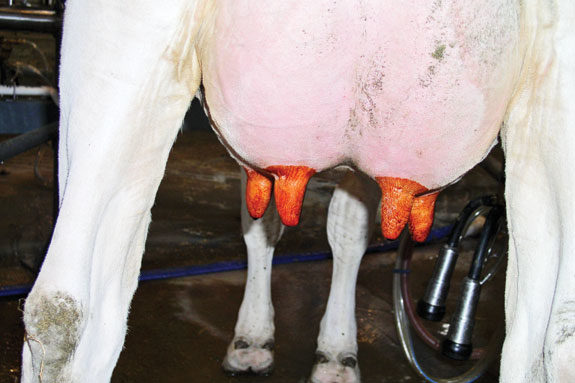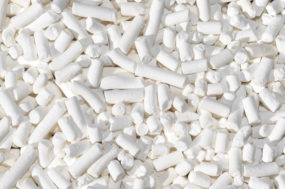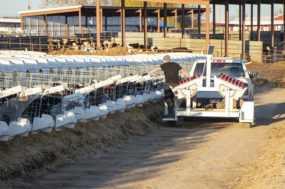There are enough teat dips and different teat dip formulations on the market to make your head spin (and kudos to whomever can pronounce the names of all the ingredients listed on a teat dip label). All the different active ingredients, skin conditioners and varying percentages of both can make choosing the right teat dip for your farm a daunting task.
For years, iodine was the most popular choice due to its broad spectrum of activity against major mastitis pathogens, fast-acting kill power and cost-effectiveness. In light of the recent price increases of iodine, however, dairy producers may be inclined to search for an alternative teat dip.
Iodine
Iodine has a long history as a teat dip. It is the most tested germicide in the dairy industry. Iodine is an oxidizer, meaning it “burns up” vital cell components of bacteria, fungi and some spores. And it is economical, or it used to be.
The tsunami in Japan (which is one of the world’s two major suppliers of iodine) has affected the pricing and availability of iodine. Since that time we have seen increases in the price of iodine teat dip, and we do not know if or when iodine will decrease in price.
Another important factor when considering an iodine teat dip is that not all iodine products are created equal. Make certain you are buying your iodine from a reputable supplier and that the iodine levels measure up to label claims.
If you are skeptical of the iodine content in the product you are using, there are independent labs that can provide you with accurate results.
Iodine is available in every concentration from 0.03 percent to 1 percent. The concentration you choose should be based on what is effective in your herd. If you are using a 0.25 percent concentration and feel your udder health could be better, switching to a higher concentration of iodine may be one way to achieve that goal.
However, iodine can also be irritating to teat skin, especially if the skin is chapped, cracked or damaged in some other capacity. Skin conditioners and pH buffers are also an important consideration but outside the scope of this article.
Chlorhexidine
The second teat dip ingredient that we often see in the market place is chlorhexidine. Chlorhexidine is a salt and commonly comes in two forms, chlorhexidine gluconate and chlorhexidine acetate (chlorhexidine is the active germicide). There is no research available to indicate that one is more effective than the other.
Chlorhexidine kills bacteria cells by disrupting their membrane. Often, teat dips will contain 0.50 percent chlorhexidine salt. There is sufficient research that chlorhexidine is effective at this concentration. Concentrations lower than this tend to be ineffective.
Chlorhexidine has two very beneficial properties. It is non-irritating, and it offers a residual effect, meaning it kills for extended periods of time after the teat is dipped. These two qualities make it an excellent choice for a post-dip, but chlorhexidine is also a more-than-adequate pre-dip.
Historically, chlorhexidine has been more expensive than iodine, which is one reason why we see more iodine teat dips being sold. At the moment, however, chlorhexidine teat dips may be less expensive than many of the iodine products.
Chlorhexidine is not as “broad spectrum” as iodine but, in most cases, it is a very effective dip (data suggests chlorhexidine is less effective against Pseudomonas and Serratia species). Chlorhexidine dips also have a neutral pH which, combined with it being a non-irritant, makes it an excellent dip for damaged teats.
ASC
Acidified sodium chlorite (ASC) may not be something that sounds familiar to you. But it is a popular germicide. ASC products come with a base and an activator that must be mixed just prior to milking. (Sound familiar now?)
ASC, another oxidizer like iodine, provides fast-acting and broad spectrum germicidal activity against bacteria, yeasts, molds and viruses. It is as effective as iodine but not as popular because it was historically more expensive, and as I already mentioned, it must be mixed immediately prior to use.
However, with iodine prices on the rise, ASC dips may now be a more viable option on many dairies. Additionally, several pumps are available that automatically mix the dips, assuring that the right concentrations of base and activator are present while reducing labor.
Some, but not all, ASC dips tend to provide excellent teat conditioning. There are also some ASC dips that have been evaluated under National Mastitis Council (NMC) protocols and showed outstanding effectiveness against major mastitis-causing organisms. These dips make excellent pre-dips or post-dips.
Hydrogen peroxide
Hydrogen peroxide is a relative newcomer to the marketplace. Although there are only a few National Mastitis Council protocol studies on hydrogen peroxide, the anecdotal data is quite good and there are some challenge tests that indicate it is effective against the major mastitis-causing pathogens.
Hydrogen peroxide is very cost-effective and a broad spectrum germicide. It, too, is an oxidizer. We often see hydrogen peroxide blended with an organic acid. This gives the germicidal activity a little extra oomph. The “fizzing” action of hydrogen peroxide on the teat helps to physically clean them, making it an excellent pre-dip.
Hydrogen peroxide is sensitive to direct sunlight and extreme temperatures, and the shelf life is not as long as some of the other germicides. It is important to store hydrogen peroxide dips out of these conditions.
Other germicides
There are many different germicides that have been used as teat dips, and there is no way I could cover them all in one article, but there are a few more that deserve a mention.
Bronopol and nisin are two germicides that have been used in dips. Bronopol is a synthetic compound that is often used as a preservative. Nisin is a naturally derived peptide. Both have demonstrated some efficacy as a teat dip.
Organic acids
The last group I will discuss is organic acids. Organic acids include (but are not limited to) salicylic acid, capric acid, caprylic acid, heptanoic acid, lactic acid and dodecylbenzene sulfonic acid (DDBSA).
Organic acids disrupt the cell membrane of bacteria and may inactivate some essential enzymes. Usually these acids are not used as a standalone germicide in teat dips; however, there are exceptions.
Of these acids, DDBSA and lactic acid have the most efficacy data generated under NMC protocols. These acids do work quite well with other actives, provide a synergistic effect and are very cost-effective.
One way to combat increasing iodine prices may be to use a lower level of iodine in conjunction with an organic acid to maintain a greater level of germicidal activity.
Take-home message
Clearly, plenty of teat dip options exist. But it is important to remember that the active ingredient in teat dips might not be effective if the teat dip is not properly manufactured.
The active ingredients discussed above hang in a delicate balance with complexing agents, surfactants, pH buffers and skin conditioners. Upsetting this balance could leave the “active” ingredient with little to no germicidal activity.
It is important to buy your teat dips from a reputable manufacturer, that is making dips in an FDA-approved facility and that practices good manufacturing procedures (or GMPs) as described by the FDA. The water source for teat dips should be tested for mineral content and pH, as well as being cultured on a regular basis, since mineral content, pH and bacteria in the water can affect the efficacy of the teat dip.
Each batch of teat dip should be tested as well, to be certain it is free of pathogenic bacteria and contains the amount of active ingredient specified on the label.
Additionally, the National Mastitis Council publishes a “Summary of Peer-Reviewed Publications on Efficacy of Premilking and Postmilking Teat Disinfectants” each year. This summary includes all teat dips that have been tested since 1980 according to NMC guidelines, with the results published in a peer-reviewed journal article (i.e., Journal of Dairy Science ).
This is an excellent source for teat dips that have been proven efficacious. You can find this information as well as other valuable fact sheets and troubleshooting guides at www.nmconline.org
When you are making the decision on which teat dip to use, it is important to remember that your cows are your most valuable asset. The most economical teat dip may not be the best choice to use in your mastitis prevention and quality milk program.
You wouldn’t put the wrong kind of oil in your brand-new tractor; why would you put a questionable teat dip on your cows’ teats? PD
Belsito completed post-graduate work at the University of Florida , specializing in mastitis research.
PHOTO:
TOP RIGHT: The most economical teat dip may not be the best choice to use in your mastitis prevention and quality milk program. You wouldn’t put the wrong kind of oil in your brand-new tractor; why would you put a questionable teat dip on your cows’ teats? Photo by PD staff.

Jessica Belsito
Marketing Director
IBA Inc.
jbelsito@iba-usa.com








